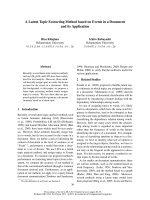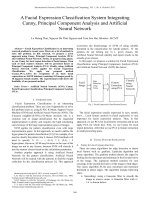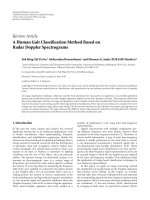facial expression classification method based on pseudo-zernike moment and radial basis function network
Bạn đang xem bản rút gọn của tài liệu. Xem và tải ngay bản đầy đủ của tài liệu tại đây (427.19 KB, 4 trang )
Facial Expression Classification Method Based on Pseudo-Zernike Moment and
Radial Basis Function Network
Tran Binh Long
1
, Le Hoang Thai
2
, Tran Hanh
1
1
Department of Computer Science,
University of Lac Hong
10 Huynh Van Nghe, DongNai 71000, Viet Nam
2
Department of Computer Science,
Ho Chi Minh City University of Science
227 Nguyen Van Cu, HoChiMinh 70000, Viet Nam
Abstract—This paper presents a new method to classify facial
expressions from frontal pose images. In our method, first
Pseudo Zernike Moment Invariant (PZMI) was used to extract
features from the global information of the images and then
Radial Basis Function (RBF) Network was employed to classify
the facial expressions, based on the features which had been
extracted by PZMI. Also, the images were preprocessed to
enhance their gray-level, which helps to increase the accuracy
of classification. For JAFFE facial expression database, the
achieved rate of classification in our experiment is 98.33%.
This result leads to a conclusion that the proposed method can
ensure a high accuracy rate of classification.
Keywords - facial expression classification, pseudo Zernike
moment invariant, RBF neural network.
I. INTRODUCTION
Facial expressions deliver rich information about human
emotions, and thus play an essential role in human
communications. For facial expression classification, data
from static images or video sequences are used. In fact, there
have been many approaches for facial expression
classification, using static images and image sequences
[1][2].Those approaches first track the dynamic movement
of facial features and then classify the facial feature
movements into six expressions (i.e., smile, surprise, anger,
fear, sadness, and disgust). Classifying facial expression
from static images is more difficult than from video
sequences because less information during the expression is
available [3].
In order to design a highly-accurate classification system,
the choice of feature extractor is very crucial. There are two
approaches for feature extraction extensively used in
conventional techniques [4]. The first approach is based on
extracting structural facial features that are local structure of
face images, for example, the shapes of the eyes, nose and
mouth. This structure- based approach deals with local
information. The second approach is based on statistical
information about the features extracted from the whole
image, so it uses global information. [5]
Our proposed facial expression classification system is
composed of three stages (Fig.1). In the first stage, the
location of face in arbitrary images was detected. To ensure a
robust, accurate feature extraction distinguishing between
face and non-face region in an image, exact location of the
face region is needed. We used a ZM-ANN technique which
had been already presented in reference [6] for face
localization and created a sub-image which contains
information necessary for classification algorithm. By using
a sub-image, data irrelevant to facial portion are disregarded.
In the second stage, the pertinent features from the localized
image obtained in the first stage were extracted. These
features are obtained from the pseudo Zernike moment
invariant. Finally, facial images based on the derived feature
vector obtained in the second stage were classified by RBF
network. Also, only automatic classification of facial
expressions from still images in Japanese Females Facial
Expression (JAFFE) database (Fig.2) [7] is discussed.
Fig.1. The chart of PZMI-RBF system
The remainder of the paper is organized as follows:
section 2 describes the preprocessing procedure to get the
pure expression image; section 3 presents the pseudo Zernike
feature extraction and our feature vector creation; section 4
discusses the classification based on RBF network, section 5
presents the experiments on the JAFFE facial expression
database, and section 6 mentions our conclusions.
Fig.2. Examples of seven principal facial expressions in JAFFE:
smile, disgust, anger, surprise, fear, neutral, and sadness (from left
to right).
II. FACE LOCALIZATION METHOD
Many algorithms have been proposed for face
localization and detection, which can be seen from a critical
survey [8]. Face localization helps find an object in an
image to be used as the face candidate. The shape of this
object resembles that of a face. Thus, faces are characterized
by elliptical shape. In other words, an ellipse can
approximate the shape of a face. A ZM-ANN technique
presented in [6] has proven to be able to find the best-fit
ellipse to enclose the facial region of the human face in a
frontal pose image.
The operation of face detection is done in two phases:
• In the first phase, representative Zernike vector is
extracted from a selected image by a proper algorithm.
• In the second phase, a three- layer perceptron neural
network, beforehand trained, receives on its input layer the
Zernike moments vector and then gives on its output layer a
Input
image
Sub image
ZM-ANN
Feature
PZMI vector
Classifier
RBF
Output
set of points representing the probable contour of the face
contained in the original image.
The neural network is used to extract statistical
information contained in the Zernike moments and in the
interactions closely related to the determined face region of
the selected image. (Fig.3)
Fig.3. General diagram of the system detection
Generally, the implementation of our method can be
briefly described as follow:
• Computing vectors of Zernike moments for all the images
(N) in the work database.
• Constructing training database by randomly choosing M
images from the work database (M<<N) and identifying
Zernike moment vectors Z
i
corresponding to M images.
• Manually delaminating face area in each image of the
training database based on a set of points representing the
contour C
i
of each treated face. The points include the top,
bottom, left and right of identified image and they form an
ellipse whose semi-major axis a= 45, semi-minor axis b=40,
rate b/a 8/9 (see fig.5.a).
• Training neural network on the set of M couples (Z
i
,C
i
).
The test and measurement of the performance of the network
obtained after training operation were done on (N-M) the
other images in the work database.
III. FEATURE EXTRACTION TECHNIQUE
Feature extraction is defined as a process of converting a
captured biometric sample, i.e. face expression, into a
unique, distinctive and compact form so that it can be
compared to a reference template. According to [9], moment
sequence, M
pq
is uniquely determined by the image f(x,y)
and conversely, f(x,y) is uniquely described by M
pq
. The
uniqueness of the moment method has prompted us to its
suitability in face feature extraction. Furthermore, the
orthogonal property of the PZM enables redundancy
reduction among their respective description and thus helps
to improve the computation efficiency.
A. Pseudo Zernike Moment Invariant
The kernel of pseudo Zernike moments is the set of
orthogonal pseudo Zernike polynomials defined over the
polar coordinates inside a unit circle. The two dimensional
pseudo Zernike moments of order p with repetition q of an
image intensity function f(r,θ) are defined as [10]:
Where Zernike polynomials PV
pq
(r,θ) are defined as:
and
The real-valued radial polynomials are defined as:
and
Since it is easier to work with real functions, PZ
pq
is often
split into its real and imaginary parts,
as given
below:
Where
Since the set of pseudo Zernike orthogonal polynomials
is analogous to that of Zernike polynomial, most of the
previous discussion for the Zernike moments can be adapted
to the case of PZM.
It can be seen that Zernike moment in below equation
will become pseudo Zernike moments if the radial
polynomials, R
pq
, defined as in below equation
with its condition p-|q| = even, are eliminated [11].
Hence, pseudo Zernike moments offer more feature vectors
than Zernike moments as pseudo Zernike polynomial
contains (p+1)
2
linearly independent polynomials of
order , where as Zernike polynomial contains only
linearly independent polynomials due to
condition of p-|q|=even.
B. Feature vector creation
Fig.4. Schematic block diagram of the proposed PZMI model
Fig.5. Center of ellipse, circle determined by basing on the top,
bottom, left and right.
The computation of the vectors of pseudo Zernike
moments for all the images in the work database includes
two stages. The first stage is selecting the image region to
compute the pseudo Zernike vector. It is noticed from the
analysis of facial expressions that when the emotion changes,
the primary changing face areas are likely to be the eyes, the
Compute
Zernike
vector
Artificial
neural
network
Source image
Face detected
r
(a)
(b)
(c)
mouth, and the eyebrows (fig.5.c). The research on PZMI
shows that the farther a position is away from the center of
the circle, the larger the PZM coefficient at that position is.
Through the analyses, based on prior studies, we propose a
technique to extract the selected image area to calculate PZM
vector as follows: First, we determine the circle which is the
typical area to compute the PZM vector- illustrated in
Fig.5.c. The center of the circle coincides with that of the
ellipse with semi major axis a= 45, semi minor axis b=40,
rate b/a 8/9. The ellipse itself is the border area
surrounding the face region (fig.5.b). Our experimental
results have proved that the proposed technique enables a
full collection of eye and mouth features in Jaffe database
(Fig.4). Then, we identify the characteristic pseudo Zernike
vectors in the selected images.
With this technique, the center of the circle PZMI is
placed in such a position that it coincides with the center of
the images identified in phase 1 (where r= b)
In the second stage, the feature vector was obtained by
calculating the PZMI of the derived sub-image. According to
selecting PZMI as face feature, we defined four categories of
feature vectors based on the order (p) of the PZMI. In the
first category with p=1, 2, , 6, all moments of PZMI were
considered as feature vectors elements. The number of the
feature vector elements in this category is 26. In the second
category, p=4, 5, 6, 7 were chosen. All moments of each
order included in this category were then summed up to
create feature vectors of size 26. In the third category, p=6,
7, 8 were considered. The feature vector for this category has
24 elements. Finally, the last category with p=9, 10 was
considered with 21 feature elements.[14]
Fig.6. Original and reconstructed with different order face images.
With the results based on the value of N = 10, our
experimental study indicates that this method of selecting the
pseudo Zernike moment order as the feature elements allows
the feature extractor to have a lower-dimensional vector
while maintaining a good discrimination capability. (Fig.6)
IV. CLASSIFIER DESIGN
The major advantages of RBFN over other models such
as feed-forward neural network and back propagation are its
fast training speed and local feature convergence [12]. Thus,
in this paper, RBF neural network is used as a classifier in a
facial expression classification system where the inputs to
the neural network are feature vectors derived from the
proposed feature extraction technique described in the
previous section.
A. RBF neural network description
The radial basis function neural network (RBFN)
theoretically provides such a sufficiently- large network
structure that any continuous function can be approximated
within an arbitrary degree of accuracy by appropriately
choosing radial basis function centers [12]. The RBFN is
trained using sample data to approximate a function in
multidimensional space. A basic topology of RBFN is
depicted in Fig. 7. The RBFN is a three-layered network.
The first layer constitutes input layer in which the number of
nodes is equal to the dimension of input vector. In the hidden
layer, the input vector is transformed by radial basis function
as activation function:
where ||
||
denotes a norm- (usually Euclidean distance)- of the input
data sample vector and the center
of radial basis
function. The kth output is computed by equation
where w
kj
represents a weight synapse associates with the
jth hidden unit and the kth output unit with m hidden units.
Fig.7. Basic topology of RBFN
We employed the RBFN to classify the facial expressions
from images in the Eigen-space domain extracted via PZMI
as described in the previous section. The architecture was
depicted in Fig. 7.
B. RBF neural network classifier design
To design a classifier based on RBF neural networks, in
the input layer of the neural network, we set an amount of
input nodes which are as many as feature vector elements.
The number of nodes in the output layer is 7, equivalent to 7
facial expressions of image classes. Initially, the RBF units
are equal to the number of output nodes, and these RBF units
increase if classes are overlapped.
V. EXPERIMENTAL RESULTS
In this section, we demonstrate the capabilities of the
proposed PZMI-RBFN approach in classifying seven facial
expressions. The proposed method is evaluated in terms of
its classification performance using the JAFFE female facial
expression database [13], which includes 213 facial
expression images corresponding to 10 Japanese females.
Every person posed 3 or 4 examples of each of the seven
facial expressions (happiness, sadness, surprise, anger,
disgust, fear, neural). Two facial expression images of each
expression of each subject were randomly selected as
Original
Order 10
Order 9
Order 7
Order 5
Order 2
Order 3
Order 1
W
mk
W
11
Output
Output
Layer
Input
Layer
Hidden
Layer
.
.
r
.
.
r
.
X
1
X
2
X
p
1
2
6
7
1
2
m
j
training samples, while the remaining samples were used as
test data, without overlapping. We have 140 training images
and 73 testing images for each trial. To investigate the local
effect of the source images, we used Images size: 80 × 80.
Since the size of the JAFFE database is limited, we had
performed the trial over 3 times to get the average
classification rate. Our obtained classification rate is 98.33%
(Table I).
TABLE I. CLASSIFICATION RATE (%) OF THE PROPOSED PZMI-RBF MODEL
Test
Sadness
Smile
Disgust
Neutral
Surprise
Fear
Anger
1
97.98
97.58
98.95
98.01
98.68
97.88
98.45
2
98.8
98.88
98.76
98.87
98.64
98.46
98.95
3
98.7
96.85
96.92
97.42
98.84
98.45
98.86
For the classification performance evaluation, a False
Acceptance Rate (FAR) and a False Rejection Rate (FRR)
test were performed. These two measurements yield another
performance measure, namely Total Success Rate (TSR):
The system performance can be evaluated by using Equal
Error Rate (EER) where FAR=FRR. A threshold value is
obtained based on Equal Error Rate criteria where
FAR=FRR. Threshold value of 0.2954 is gained for PZM as
measure of dissimilarity.
Table II shows the testing result of verification rate with
order moments from setting 10 (moments order 10) for PZM
based on their defined threshold value.
The results demonstrated that the application of pseudo
Zernike moments as feature extractor can best perform the
classification.
TABLE II. TESTING RESULT OF VERIFICATION RATE OF PZM
We have compared our proposed with some of the
existing facial expression classification techniques on the
same Jaffe database. This comparative study indicates the
usefulness and the utility of the proposed technique
The three other methods taken for the comparison were
HRBFN+PCA [17], Gabor + PCA+LDA [15],
GWT+DCT+RBF [16] (see in Table III)
TABLE III. COMPARATIVE RESULTS OF THE
CLASSIFICATION RATE (%) OF DIFFERENT APPROACHES
Methods
Rate
Gabor + PCA+LDA [16]
97.33%
GWT+DCT+RBF [17]
89.11%
HRBFN+PCA [10]
95.68%
Proposed method
98.33%
VI. CONCLUSIONS
The performance of orthogonal pseudo Zernike moment
invariant (PZMI) and radial basis function neural network
(RBFN) in the facial expression classification system was
presented in this paper. It was seen from the performance
that higher orders of orthogonal moment contain more
information about face image and this improves the
classification rate. The pseudo Zernike moments of order 10
has the best performance. An RBF neural network was used
as a classifier in this classification system. The highest
classification rate of 98.33%, FAR = 2.7998% and FRR =
3.1674% with Jaffe database was achieved using the
proposed algorithm, which represents the overall
performance of this facial expression classification system.
The proposed algorithms, orthogonal PZMI+RBF N, possess
some advantages: orthogonality and geometrical invariance.
Thus, they are able to minimize information redundancy as
well as increase the discrimination power.
REFERENCES
[1] I. A. Essa, A. P. Pentland, “Coding, Analysis, Interpretation, and
Recognition of Facial Expressions”, IEEE Trans. Pattern Analysis
and Machine Intelligence, Vol. 19, 1997, pp.757-763
[2] B. Fasel, J. Luettin, “Automatic facial expression analysis: a survey”,
Pattern Recognition, Vol. 36, 2003, pp.259-275
[3] X. W. Chen and T. Huang, “Facial expression recognition: a
clustering-based approach,” Pattern Recognition Letter, Vol. 24,
2003, pp. 1295-1302.
[4] J. Daugman, “Face Detection: A Survey”, Computer Vision and
Image Understanding, Vol. 83, No. 3, pp. 236-274, Sept. 2001.
[5] L. F. Chen, H. M. Liao, J. Lin and C. Han, “Why Recognition in a
statistic-based Face Recognition System should be based on the pure
Face Portion: A Probabilistic decision-based Proof”, Pattern
Recognition, Vol. 34, No.7, pp. 1393-1403, 2001.
[6] DangThanhHai, LeHoangThai, LeHoaiBac, “Facial boundary detect
in images using Moment Zernike and Artificail Neural Network,”
Dalat University’s Information technology Conference 2010, pp. 39-
49, DaLat, Vietnam, Dec-3-2010 (in Vietnamese)
[7] www.kasrl.org/jaffe.html.
[8] J. Daugman, “Face Detection: A Survey”, Computer Vision and
Image Understanding, Vol. 83, No. 3, pp.236-274, Sept. 2001
[9] Hu. M.K,. Visual pattern recognition by moment invariant. IRE
Trans. On Information Theory, vol. 8,No. 1, pp. 179-187, 1962.
[10] R. Mukundan and K.R. Ramakrishnan, Moment functions in image
analysis – theory and applications. World Scientific Publishing, 1998.
[11] C.H. Teh and R.T. Chin. On image analysis by the methods of
moments. IEEE Trans. Pattern Anal. Machine Intell., vol. 10, pp. 496-
512, July 1988.
[12] S. Haykin, Neural Networks: A Comprehensive Foundation,
Macmillan College Publishing Company, New York, 1994.
[13] M. J. Lyons, S. Akamatsu, M. Kamachi, J. Gyoba, “Coding Facial
Expressions with Gabor Wavelets”, In: Proceedings of the 3th IEEE
International Conference on Automatic Face and Gesture
Recognition, Nara, Japan, 1998, pp.200-205
[14] Javad Haddadnia, Majid Ahmadi, Karim Faez, “An Efficient Human
Face Recognition System Using Pseudo Zernike Moment Invariant
and Radial Basis Function Neural Network,” International Journal of
Pattern Recognition and Artificial Intelligence Vol. 17, No. 1 (2003)
41-62 World Scientific Publishing Company
[15] Hong-Bo Deng, Lian-Wen Jin, Li-Xin Zhen, Jian-Cheng Huang, “A
New Facial Expression Recognition Method Based on Local Gabor
Filter Bank and PCA plus LDA,”International Journal of Information
Technology, vol. 11, no.11, 2005.
[16] Praseeda Lekshmi.V, Dr.M.Sasikumar,”A Neural Network Based
Facial Expression Analysis using Gabor Wavelets,” World Academy
of Science, Engineering and Technology 42, 2008.
[17] Daw-Tung Lin,”Facial Expression Classification Using PCA and
Hierarchical Radial Basis Function Network,” Journal of Information
Science and Engineering 22, 1033-1046, 2006.
moment
thres
FAR(%)
FRR(%)
TSR(%)
PZMI
0.2954
2.7998
3.1674
98.33









